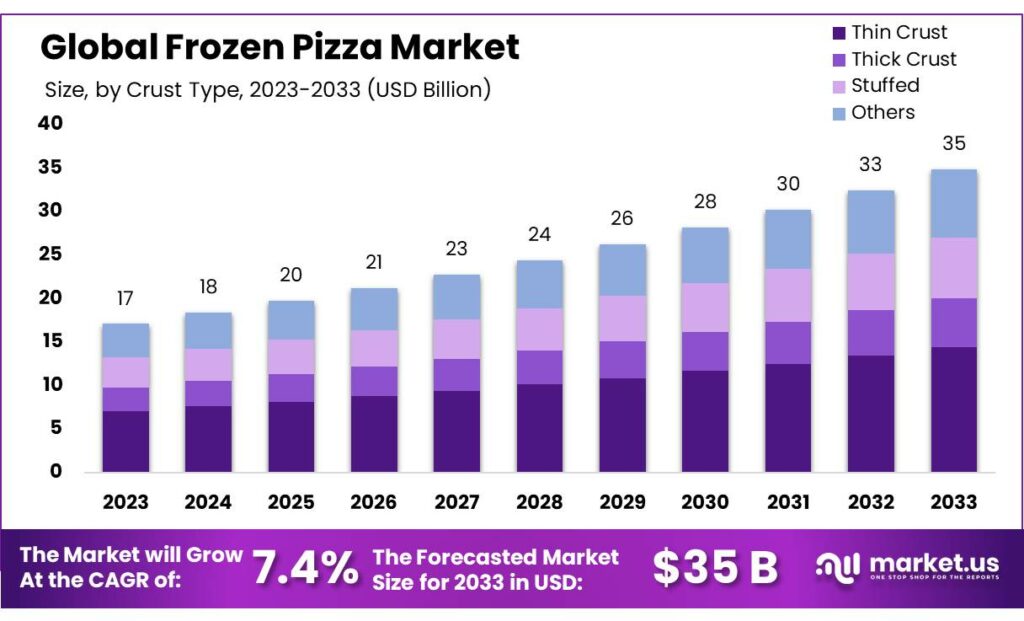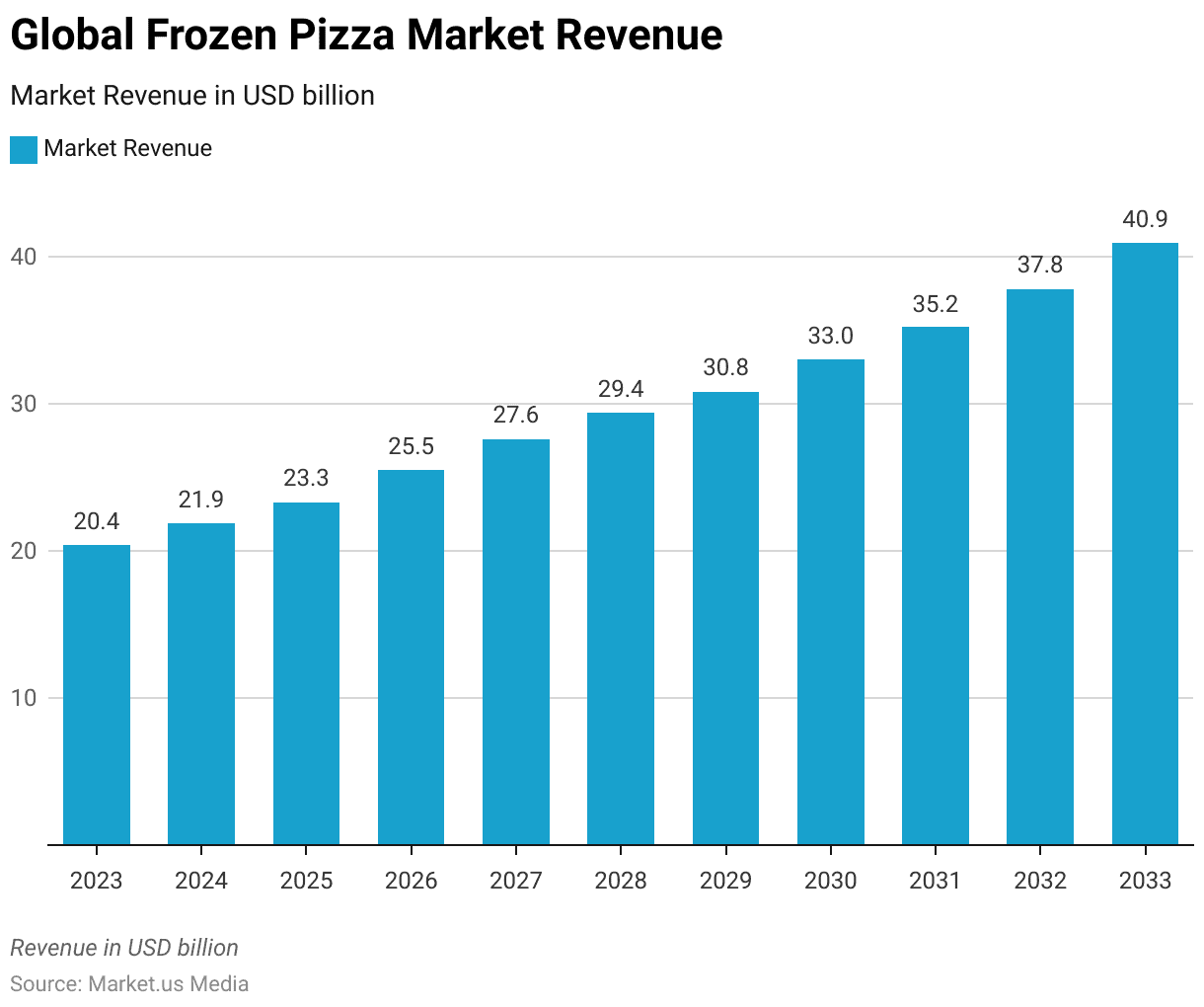Table of Contents
- Introduction
- Editor’s Choice
- Global Frozen Pizza Market Overview
- History and Evolution of Frozen Pizza
- Leading Frozen Pizza Brands Ranked by Brand Awareness
- Frozen Pizza Sales and Prices Statistics
- Consumption of Frozen Pizza
- Preferred Frozen Pizza Flavors
- Key Consumer Trends and Response
- Changing Preferences Among Consumers Due to Inflation
Introduction
According to Frozen Pizza Statistics, Frozen pizza, a household staple worldwide, offers convenience and variety. Typically composed of a crust and assorted toppings and packaged in cardboard boxes, production involves dough preparation, application, flash-freezing, and packaging.
With a global presence in supermarkets and online food delivery platforms, frozen pizza comes in diverse varieties, including gluten-free and vegetarian options.
Branding and marketing drive consumer choices in a competitive market where established brands and newcomers vie for market share through innovation and pricing strategies.
Understanding these basics provides insight into the broader landscape of the frozen pizza industry, including market trends and growth opportunities.
Editor’s Choice
- The global frozen pizza market revenue reached USD 20.4 billion in 2023.
- In 2029, the market revenue is estimated to reach USD 30.8 billion, with non-vegetarian pizzas contributing USD 19.03 billion and vegetarian pizzas USD 11.77 billion.
- As of the latest data, meat toppings dominate the market with a commanding 56% share, indicating a strong preference for protein-rich options among consumers.
- In 2023, DiGiorno secured the highest brand awareness percentage at 84% in the U.S.
- According to data from Circana for the 52 weeks ending April 23, 2023, the frozen pizza subcategory in the United States saw a significant increase of 10.7% in dollar sales, reaching $6.8 billion across various retail channels such as grocery, drug, and mass market.
- Among respondents, 36% enormously liked spicy food, 53% favored chicken, and 32% preferred pepperoni to an extreme degree.
- About 60% of consumers mentioned consuming frozen or delivered pizza once a week or every two to three months.

Global Frozen Pizza Market Overview
Global Frozen Pizza Market Size
- The global frozen pizza market revenue has shown a steady upward trajectory over the years at a CAGR of 7.4%, reaching USD 20.4 billion in 2023 and experiencing consistent growth after that.
- In 2029, the revenue peaked at USD 30.8 billion, showcasing sustained market demand.
- The upward momentum persisted, with revenues hitting USD 33.0 billion in 2030 and rising to USD 35.2 billion in 2031.
- By 2032, the market revenue surged to USD 37.8 billion, highlighting significant growth opportunities.
- This positive trajectory is expected to continue, with revenue projections reaching USD 40.9 billion in 2033, reflecting frozen pizza products’ enduring popularity and consumer appeal globally.

Frozen Pizza Market Size – By Type
- The global frozen pizza market, segmented by type into non-vegetarian and vegetarian options, has consistently grown.
- In 2023, the total market revenue stood at USD 20.4 billion, with non-vegetarian pizzas generating USD 12.61 billion and vegetarian pizzas contributing USD 7.79 billion.
- By 2025, the market size reached USD 23.3 billion, with non-vegetarian pizzas accounting for USD 14.40 billion and vegetarian pizzas for USD 8.90 billion.
- In 2029, the market revenue reached USD 30.8 billion, with non-vegetarian pizzas contributing USD 19.03 billion and vegetarian pizzas USD 11.77 billion.
- This upward trajectory continued through 2030 and 2031, with the market reaching USD 33.0 billion and USD 35.2 billion, respectively, before peaking at USD 40.9 billion in 2033.

Global Frozen Pizza Market Share – By Toppings
- The global frozen pizza market’s distribution of market share by toppings reveals distinct preferences among consumers.
- As of the latest data, meat toppings dominate the market with a commanding 56% share, indicating a strong preference for protein-rich options among consumers.
- Following behind are vegetable toppings, holding a significant 26% share, reflecting the growing demand for healthier and plant-based choices.
- Cheese toppings, renowned for their classic appeal, secure a respectable 14% market share.
- Meanwhile, other toppings collectively make up 3% of the market share, indicating a smaller but still notable niche within the industry.

History and Evolution of Frozen Pizza
- The method of flash-freezing, pioneered by Clarence Birdseye in 1924, revolutionized food preservation, including pizza.
- However, the origins of the development of frozen pizza for mass consumption are contested. Joe Bucci is one claimant, having patented a method for freezing dough in 1950 to prevent sogginess, ideal for frozen pizza.
- In 1979, Schwan initiated a marketing campaign with the formation of the “Red Baron Squadron,” using World War II-era biplanes.
- Over nearly three decades, these planes, renowned for their aerobatics and likely affinity for pizza, flew over 80,000 passengers, becoming the longest-serving civilian aerobatic team in the United States. Presently, Red Baron remains Schwan’s leading frozen pizza brand.
- In 1995, according to Brendan Koerner in The New York Times in 2004, the introduction of Kraft Foods’ DiGiorno brand marked a pivotal moment in the history of frozen pizza.
Leading Frozen Pizza Brands Ranked by Brand Awareness
- In 2023, brand awareness rankings for leading frozen pizza brands in the United States highlighted the dominance of household names in the market.
- Topping the list, DiGiorno secured the highest brand awareness percentage at 84%, closely followed by Red Baron at 83% and Totino’s Party Pizza at 82%. These established brands have successfully penetrated the consumer consciousness with their marketing efforts and product quality.
- Tony’s and Stouffer’s also garnered substantial recognition, with 77% and 76% brand awareness percentages, respectively.
- Further down the ranking, Tombstone, California Pizza Kitchen, and Freschetta maintained respectable positions, with awareness levels ranging from 73% to 54%.

Frozen Pizza Sales and Prices Statistics
- Last year, frozen pizza sales surged by 11%, attributed to heightened promotional efforts by retailers. Consequently, 13% of pizza restaurant customers opted for frozen or non-restaurant pizza due to inflation, per a recent report from marketing firm Vericast.
- Additionally, the top four pizza companies experienced a 3% decline in market share.
- According to data from Circana for the 52 weeks ending April 23, 2023, the frozen pizza subcategory in the United States saw a significant increase of 10.7% in dollar sales, reaching $6.8 billion across various retail channels such as grocery, drug, and mass market.
- However, unit sales experienced a decline of 2.8%, totaling less than 1.4 billion units sold. The average price per unit rose notably by 13.9% to $4.94.
- Similarly, sales of pizza slices experienced an 18.3% increase, totaling $630.2 million, with volume up by 8.5% to 240.5 million slices. Pizza slice prices also rose 9.0%, reaching $2.62 per slice.
Consumption of Frozen Pizza
- The consumption of frozen pizzas in the United States, purchased in a frozen state has exhibited a steady trend from 2014 to 2024.
- According to the provided data, the consumption figures indicate consumers’ consistent preference for this convenient food option.
- From 2014 to 2015, there was a marginal increase in consumption, with figures rising from 198.14 million to 198.65 million.
- Despite minor fluctuations in subsequent years, the overall trajectory reflects a stable demand for frozen pizzas.
- In subsequent years, including 2021 to 2024, they maintained a similar pattern, with consumption figures hovering around the 200 million mark.

Preferred Frozen Pizza Flavors
- Consumer preferences for frozen pizza based on various flavors were analyzed across three categories: spicy food, chicken, and pepperoni.
- Among respondents, 36% enormously liked spicy food, 53% favored chicken, and 32% preferred pepperoni to an extreme degree.
- Moderately, 34% moderately liked spicy food, 28% for chicken, and 37% for pepperoni.
- Moreover, 18% found spicy food just fine, along with 17% for chicken and 27% pepperoni.
- Disinterest was noted, with 10% showing a moderate dislike for spicy food, 1% for chicken, and 3% for pepperoni.
- A minimal percentage, 2% for spicy food and 1% for chicken and pepperoni indicated an extreme dislike.

Key Consumer Trends and Response
- About 60% of consumers mentioned consuming frozen or delivered pizza once a week or every two to three months. On the other hand, approximately 70% of consumers reported preparing homemade pizza, albeit less frequently than other options, with 52% indicating they make it once a month or less.
- Notably, 43% of individuals who recently dined at pizza restaurants now opt to purchase frozen pizza during a typical week.
- This shift towards at-home pizza consumption is underscored by a nearly 11% surge in frozen pizza sales over the past year alone. Consequently, retailers are capitalizing on this trend, witnessing market share and consumer spending growth.
Changing Preferences Among Consumers Due to Inflation
- Most surveyed consumers (64%) believe that the rising prices of dining out make it too costly. However, 41% acknowledge that increasing food prices at grocery stores doesn’t necessarily make eating at home cheaper.
- Consequently, consumers are seeking cost-effective options and are drawn to deals. Half (50%) rely on coupons and discounts when choosing restaurants; these savings can persuade 53% to try new dining establishments.
- Moreover, 42% of those who dine out frequently use Save Direct Mail to decide where to eat, with nearly 80% admitting they spend more at restaurants when offered a coupon or discount.
- Among regular pizza consumers, 58% report that a coupon or discount influenced their dining decisions in the past month.
Discuss your needs with our analyst
Please share your requirements with more details so our analyst can check if they can solve your problem(s)



